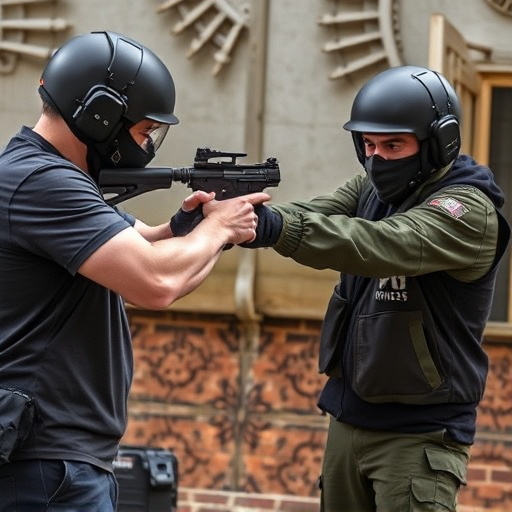Stun guns work by delivering high-voltage, low-current electric pulses through electrodes, overloading nerve cell membranes and causing muscle spasms and disorientation—non-lethal effects designed to paralyze assailants temporarily. Their impact duration varies based on device specifications and targeted areas, offering victims an escape or help-seeking window. Evaluating stun guns involves understanding their nervous system effects, with key factors including pulse width, current levels, coverage area, and range; advanced models offer adjustable pulse settings and LED target indicators for improved self-defense accuracy.
In today’s world, self-protection is a serious concern. Among non-lethal options, stun guns offer a powerful deterrent against potential threats. This article delves into the fascinating topic of stun gun effects on the nervous system, exploring the mechanisms behind their effectiveness. We’ll guide you through essential specs to consider when choosing a reliable self-defense device, ensuring your safety without causing lethal harm.
- Stun Gun Effects on Nervous System: Understanding the Mechanisms
- Specs to Consider for Effective Non-Lethal Self-Protection Devices
Stun Gun Effects on Nervous System: Understanding the Mechanisms

Stun guns, also known as electronic control devices (ECDs), work by temporarily disrupting the nervous system’s electrical signals. The primary mechanism involves delivering a high-voltage, low-current electric pulse through two electrodes in contact with the target’s body. This pulse overloads nerve cell membranes, causing them to fire uncontrollably and leading to muscle spasms and disorientation. The effects are designed to be non-lethal but can cause temporary paralysis, making it challenging for an assailant to continue attacking or flee.
Understanding the stun gun’s impact on the nervous system is crucial in appreciating its effectiveness as a self-defense tool. The electric pulse interrupts the body’s normal electrical signals, specifically affecting the neural pathways responsible for motor control and sensory perception. This disruption can last from several seconds to up to half an hour, depending on the device’s specifications and the area targeted. While it may not always result in permanent damage, the temporary disablement can provide a critical window of opportunity for victims to escape or seek help.
Specs to Consider for Effective Non-Lethal Self-Protection Devices

When evaluating non-lethal self-protection devices, understanding their effects on the nervous system is paramount. The stun gun, a popular choice, works by delivering an electric shock that disrupts motor functions and temporarily paralyzes the target. This disruption is achieved through high voltage, low current electrical pulses, typically ranging from 50,000 to 150,000 volts. The specific specs to consider here include pulse width (the duration of each shock), current levels, and delivery mechanisms, as these directly influence the device’s effectiveness and safety.
Moreover, the area of coverage and the distance at which the stun gun can be effective are crucial factors. Narrow beam angles may require users to aim precisely, while wider angles offer easier targeting but might reduce the impact. Range is also critical; shorter ranges mean closer proximity to the assailant, increasing risk. Advanced devices incorporate features like adjustable pulse settings and LED target indicators for better control and accuracy, enhancing their overall performance in self-defense scenarios.
The understanding of a stun gun’s effect on the nervous system is pivotal in developing effective non-lethal self-protection devices. By knowing how these tools disrupt motor control and sensory perception, we can enhance their design to ensure safety without causing lasting harm. When selecting specs for such devices, prioritizing energy output, contact area, and control features is essential. These considerations, combined with an awareness of the stun gun’s mechanisms, will foster the creation of innovative, reliable, and user-friendly non-lethal self-defense solutions that protect individuals without crossing the line into lethal force.
